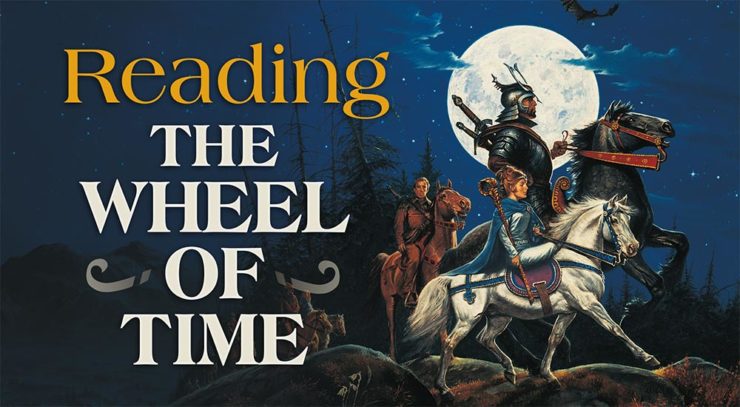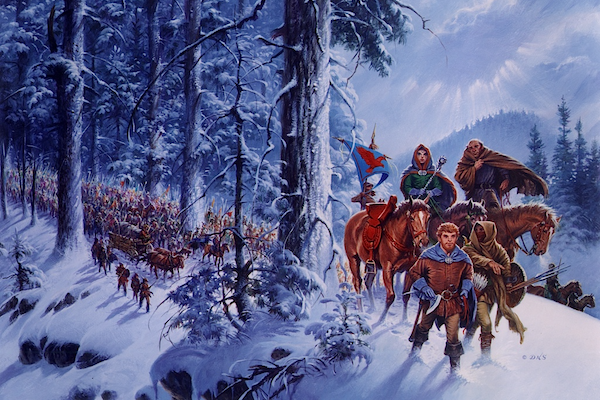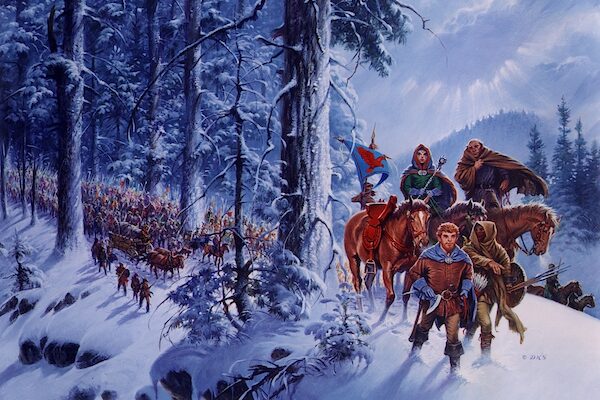Well, here we are. Rand and company have come to the end of their first adventure, and so have I. There are many more to come, of course, but for the moment, evil is beaten down and spring has come again to the world spun into being by the Wheel of Time. And yet, there is much loss and sadness too, and the future of our heroes, especially the boys, contains more questions than answers. This installment of Reading The Wheel of Time covers the final two chapters: 52 and 53.
Rand awakes on the top of the cliff, surprised that he can think again, and seems to be coming slowly back to himself. He realizes he is lying in a pile of greasy ashes that was once Aginor and scrambles backwards, only to nearly tumble off the edge of the precipice. He vomits, then edges backwards and rolls over on the grass, pulling the heron-marked blade from its sheath. He examines it, remembering the significance of the blade but also noting that it is only steel. Either it had been something else before, or it was another sword entirely that he wielded against the Dark One.
“My name,” he said after a while, “is Rand al’Thor.” More memory crashed back into his head like a lead ball, and he groaned. “The Dark One,” he whispered to himself. “The Dark One is dead.” There was no more need for caution. “Shai’tan is dead.” The world seemed to lurch. He shook in silent mirth until tears poured from his eyes. “Shai’tan is dead!” He laughed at the sky. Other memories. “Egwene!” That name meant something important.
Staggering to his feet, Rand walks back down the slope, weak, wavering, barely able to hold himself up. He can’t remember who Egwene is, only that she is important and he gains first speed, then stamina as he runs, until he crashes into the clearing where the oak that grew where the Green Man died stands, and finds a pretty girl who looks up at him when he calls for Egwene. Only then does he recognize her, and the rest of memory return.
Buy the Book
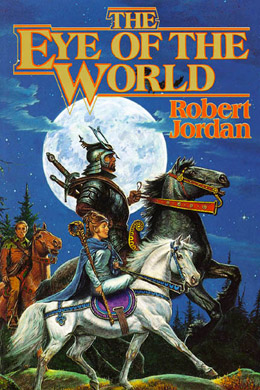

The Eye of the World
Rand goes to her, asking if she is alright, recognizing Nynaeve beside her and Moiraine lying on their folded cloaks, her own spread over her. When he touches Egwene’s face, he feels like she pulls away slightly, but she assures him that she’s unhurt and asks if he’s okay. Rand answers that with a little rest he will be “newmade,” and then checks in with the other women. Nynaeve tells him that only Moiraine was really hurt, but Moiraine insists it’s mostly just her pride, and while she looks worn, she seems alert and her gaze is strong. She explains that the seal around the Dark One’s prison must have weakened just enough to let Aginor and Balthamel, trapped nearest the surface, to escape, and that they are lucky that only two of them were freed.
Rand tells her that it doesn’t matter anymore, because they are both dead, and so is the Dark One, who he starts to name as Shai’tan before Moiraine cuts him off and tells him it would be best to continue to call him the Dark One, or at least Ba’alzamon. Rand doesn’t care, but as he starts to explain how the Dark One died he realizes what it means, that he, a man, wielded the One Power, and he can see in the women’s faces that they have realized it too. He reaches for Egwene again, and this time her pulling away is obvious, but the next moment she throws her arms around his neck and hugs him close, apologizing. Nynaeve tells him that he is still Rand al’Thor of the Two Rivers, but that he is also too dangerous now.
Moiraine demands that Rand tell her everything, and he finds himself leaving nothing out, crying as he talks about his mother, telling them about the sword of Light, cutting the black cord, and Ba’alzamon burning. Egwene hugs him tightly as he explains how it didn’t feel like it was really him performing those actions, but rather the Light just pulling him along. Moiraine tells him that she suspected this, although she wasn’t sure, because of the way that Rand resisted the bonding through her coin, and then more so because of Bela’s unflagging strength the night on Watch Hill.
“She could have outrun Mandarb, that night. I should have thought of who Bela carried. With Trollocs on our heels, a Draghkar overhead, and a Halfman the Light alone knew where, how you must have feared that Egwene would be left behind. You needed something more than you had ever needed anything before in your life, and you reached out to the one thing that could give it to you. Saidin.”
Rand asks if he might be okay, not go mad, if he never touches saidin again, and Moiraine says it might be possible, through a supreme effort of will, and that it would be easier if he had someone to teach him. She can’t, because saidin and saidar are opposites of each other, and it would be like a fish teaching a bird to swim. But Rand is stubborn enough, and his will might be strong enough.
Rand learns that the others went back into the cavern to see the Eye of the World. Now drained of the pool of saidin, the Eye now holds a pillar with steps leading up to it, and Lan took them to investigate, after Moiraine forbid anyone from looking for Rand for fear of disturbing him. Rand is horrified that they all know, but Moiraine explains that she only told Lan, and of course Egwene and Nynaeve.
Rand asks if he is to be gentled, to which Moiraine replies that he is still ta’veren, and that maybe the Pattern still needs him. Defensively, Rand replies with Ba’alzamon’s suggestion that Tar Valon means to use him as a tool, and that he refuses to be used in such a way. Moiraine tells him, harshly, that a tool is not demeaned by being used for its intended purpose, and that Rand is letting Ba’alzamon use him by allowing his lies and trickery to direct his path.
The others comes out of the cavern just then, Lan bandaged and walking stiffly, Loial carrying a large, heavy chest, Perrin a bundle of cloth, and Mat what looks like shards of pottery. They are glad to see Rand safe, and when Loial asks what happened to him, Rand lies and says he ran until he fell and hit his head. He tells them that he found ashes and burned bits of cloth, and that he thinks Aginor is dead, but he is surprised when everyone accepts the story.
They lay their burdens down before Moiraine and she looks them over carefully. First she fits together the pieces of “pottery” to reveal the symbol of the Aes Sedai, and when she gives Lan her knife to strike it, the blade snaps.
“Cuendillar,” Moiraine said. “Heartstone. No one has been able to make it since the Age of Legends, and even then it was made only for the greatest purpose. Once made, nothing can break it. Not the One Power itself wielded by the greatest Aes Sedai who ever lived aided by the most powerful sa’angreal ever made. Any power directed against heartstone only makes it stronger.”
“Then how . . . ?” Mat’s gesture with the piece he held took in the other bits on the ground.
“This was one of the seven seals on the Dark One’s prison,” Moiraine said.
Moiraine asks for the chest next, and inside it she finds a golden curved horn inlaid with silver script. She says it must be carried to Illian, and when Loial gasps, she hands it to him for him to read the inscription in the Old Tongue. Loial translates: “The grave is no bar to my call.”
Even Lan is shaken to realize that this is the Horn of Valere, made to call the all the heroes of the Ages back to the present to fight the Dark One. Loial puts it away carefully, and Moiraine begins to muse on the fact that the Eye of the World was made in anticipation of the world’s greatest need, but was that need the use they put it to, or if was it made instead to guard these treasures. Lastly, they unroll the cloth Perrin is carrying, revealing a white banner with a red and gold figure like a serpent on it, except the serpent has legs with gold-clawed feet and a golden mane. Moiriane tells them that it is the banner of the Dragon.
She rests for a while, telling them they must all leave early as the Blight has already begun encroaching upon their haven now that the Green Man is dead. Rand asks if it is finished, and she replies that they have done what they came here to do, and tells him to sleep, and dream of home.
The next morning they can see how much devastation the Blight has brought to the place; leaves fallen and most of the flowers gone, only a few clinging to the trunk of the Green Man’s tree as it stands valiantly against the corruption. But it too is failing, the birds and butterflies gone, and everyone is somber as they mount up, Moiraine carefully secured in a litter Lan has built.
But Loial refuses to leave the tree that way, saying that it is not right that his Treebrother should fall to the Blight. He begins to sing to the tree, a beautiful song like the earth itself singing, though Rand cannot tell if it has words or not. It seems to last only a few moments but actually lasts much longer, and when Loial is finished the trees leaves are thick and green again, the oak standing strong, and the flowers growing at its trunk are bright and vibrant. He tells the others that he could not have done it if something of the Green Man was not still there, but now this little clearing will not sink into the Blight with the rest.
They don’t have to fight the Blight on the way out as the did on the way in, it is still, almost as if it is cowering away from them. Mat asks about it as they make camp, while Moiraine has Egwene and Nynaeve help her set the wards, but Lan will only explain that they struck a great blow upon the Dark One. When they reach the edges of the Blight they find the unblemished trees and foliage suddenly in the full bloom of spring, as if racing to make up for the too-long winter. When they reach the tower they hear news that there was victory at Tarwin’s Gap, and the men are amazed and laughing in the springtime air. Then they come to Fal Dara, where soldiers are wearing flowers in their hair and rejoicing at the victory, and only Ingtar, who was an hour too late to participate in the battle, isn’t in high spirits.
On Moiraine’s command they are brought immediately to Lord Agelmar. There, she is helped into a chair as she asks him about the victory in Tarwin’s Gap. Agelmar is troubled, explaining how some believed that the Light itself, or perhaps the Creator, fought in the Gap, burying the Trolloc hordes under earth, but that Agelmar himself saw a man, and what that man did must not be. Moiraine replies only that the Wheel weaves as the Wheel wills, and asks after Padan Fain, who is still imprisoned on her orders. She explains that the Green Man is dead, though they managed to win, and suggests that The Last Battle has yet to be fought.
Then she shows him the Horn of Valere, and Agelmar is eager to use it, but she tells him sharply that it must be taken to Illian, and orders him to put together a company of men to take it. Agelmar agrees, though with visible distress.
A week later, Rand and Lan are practicing swordplay at the top of a tower, Rand holding the void as he fights. Lan tells him that he is improving, but not to push it so hard. He can’t become a blademaster in a few weeks. Rand replies that he doesn’t want to be a blademaster, only to make his father proud of him, and reiterates that he is leaving soon. Lan doesn’t argue, just leaves after catching sight of Egwene.
When she asks, Rand admits that he’s planning to go away, somewhere. Egwene explains that she, Nynaeve, Mat, and Perrin are going to Tar Valon. Egwene and Nynaeve to be trained, Mat to be healed from his connection to the dagger, and Perrin just to see the great city on his way back to the Two Rivers. She asks him to come, but Rand points out harshly that the Aes Sedai would just find out what he is and gentle him. Egwene reminds him that Moiraine said he would be okay if he didn’t touch the True Source again and Rand agrees that he never will, while secretly thinking that he never meant to touch it any of the other times he did, and tells Egwene again that he has to go away. Not home, just away.
In Agelmar’s private garden, under a thick bower dotted with white blossoms, Moiraine shifted on her bedchair. The fragments of the seal lay on her lap, and the small gem she sometimes wore in her hair spun and glittered on its gold chain from the ends of her fingers. The faint blue glow faded from the stone, and a smile touched her lips. It had no power in itself, the stone, but the first use she had ever learned of the One Power, as a girl, in the Royal Palace in Cairhien, was using the stone to listen to people when they thought they were too far off to be overheard.
“The Prophecies will be fulfilled,” the Aes Sedai whispered. “The Dragon is Reborn.”
—
The Green Man’s death in last week’s chapters really broke my heart, and I came to the Read this week thinking about duty and the things that we undertake for the sake of causes bigger than ourselves. It is a common theme in epic fantasy, because any great war against evil entails a good deal of sacrifice. From Lan clearly loving Nynaeve but not being able to commit to her because of his duty; to Moraine, who chose the path to fight against the Dark One long ago; to Rand and the Two Rivers folk whose ta’veren status or connection to ta’veren leads them to a destiny that they cannot deny, so many people in this story find themselves constrained by duty and the need to sacrifice for the greater good, and this is only in book one. Surely there is more to come. But within all these important destinies and threads coming together, there is the Green Man, who by his own admission was never intended for a duty like guarding the Eye of the World, and who accepted the charge only because there was no one else to do so. And for the rest of his life he carried that charge, just because he was the only one who could. It’s sad, but also beautiful, and it made me feel a lot better when Loial’s song ensured that the oak would survive. In nature, there is no death without rebirth, after all. The Green Man lives on.
Buy the Book
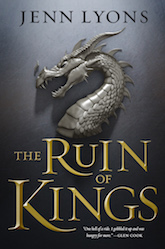

The Ruin of Kings
Meanwhile, Rand knows he can channel and believes he single-handedly killed the Dark One, but he doesn’t realize he’s the Dragon? That seems odd to me, somehow. I mean, isn’t the whole point that the Dragon is the Champion of the Light against the Dark One? He’s got to be the only person who can destroy Ba’alzamon.
In the post and the comments last week, I talked about trying to understand how the One Power and channeling actually work, and I think it’s worth noting, before I get too harsh on his reasoning skills, that neither Rand nor I understand much about it. But he seems so convinced that Ba’alzamon is dead and I have to wonder why he’s so confident. I know he saw Ba’alzamon burning, but it’s hard to believe that the human-like form was really all of the Dark One. I could see it as a piece, certainly, or maybe a projection of his power. The fact that there was that dark cord running out from him the way the Eye of the World’s light cord ran to Rand suggests that Ba’alzamon was drawing from some kind of source as well, which I don’t suspect the real, whole Dark One would do. I think Moiraine knows better, too.
The most interesting question of all for the end of this series is the question of the true purpose of the Eye of the World. Moiraine raises it herself, wondering if the pool of saidin was meant to be used or merely to protect the artifacts hidden in it. Speaking of protection, why is it that they would be protecting a broken seal? Unless it was super necessary to hide the fact that it was broken for some reason? Maybe to keep people from panicking? Or Darkfriends from getting too worked up and confident? But then, I don’t actually know how the seals work. It’s possible that they are supposed to be somewhere specific, actually clamping down the Dark One’s prison, but it’s also possible that this is a more metaphysical situation, where their physical location is not important. And if that’s the case, maybe the seal was deliberately hidden in the Eye to keep anyone from tampering with it.
Obviously it is supposed to be unbreakable, but something did break it and you can imagine that the Aes Sedai who made the Eye during the Breaking knew that nothing, not even cuendillar, can be one hundred percent foolproof. It’s even possible that Aginor broke the seal by pulling the saidin from the Eye, which would mean that Rand also had a hand in that. Was that Ba’alzamon’s plan all along? If he or one of his followers discovered the seal was in the Eye somehow, it would make sense of why they were seeking it, something that hasn’t been otherwise explained, as far as I can see. As powerful as it was said to be, it seems unlikely that Ba’alzamon would move on the Eye without having at least some idea of what he could do with it once he found it.
The inability to trust anyone has been an ongoing theme in this book, and it feels like first Nynaeve’s experience, then Perrin’s, have led us up a ladder to the even more dramatic struggle that Rand will now have to face coming to terms with his abilities and what people will think if they find out, now that his channeling carries the danger of the taint’s madness. Although he hasn’t yet realized that he is the Dragon Reborn, he knows from Moiraine’s hints that he isn’t just a channeler but a powerful one, and that will certainly haunt him in the next book. He’s not only worried about what will happen to him if the wrong people find out about his abilities, but he’s also worried about what he might do to them, if he does go mad from the taint. (I assume in one of these books they’re going to fix the taint, because it’d be hard—although interesting—to have a 14-book series in which your most powerful hero can never use his abilities. Or maybe there are a bunch more secret pools of saidin out there, who knows.)
And then there is Egwene. Although we the readers know it’s probably Rand’s destiny as the Dragon that will keep them apart, no doubt Rand is remembering Min’s words and thinking that it is the danger of madness that means he can never be with Egwene, or anyone, for that matter. How lonely he must be feeling, and even Moiraine, the one person who might have useful information, seems to be avoiding him. The narration doesn’t get into it very much, but there is something in the tone that makes me feel that loneliness too.
“Not home.” Someplace where there aren’t any people to hurt if I can’t stop myself. Somewhere alone. Suddenly it felt as cold as snow on the balcony. “I’m going away, but not home.” Egwene, Egwene, why did you have to be one of those . . . ? He put his arms around her, and whispered into her hair. “Not ever home.”
And yet he keeps learning to use the sword, to keep Tam close to him. I think there is a beautiful symbolism in Rand’s decision that as long as he carries it, he can call himself Tam’s son, even though he seems to have accepted that biologically he is not. I believe family is what you make, not just what ties you by blood, and it’s nice to see Rand embracing that.
I hope we get to spend some time with Egwene’s POV in the next book. I find her charming, in a Hermione Granger sort of way, a little sharp with people who aren’t as quick as her, but she has a warmth that attracts people. When Moiraine mentioned how Rand channeled for the first time to help Bela, needing to save Egwene more than he had needed anything in his life, the phrasing suddenly reminded me of how Nynaeve also channeled for the first time because she was frightened for Egwene’s life. In the ensemble Egwene hasn’t had as much to do yet, and I’d like to spend more time with her and learn more about what makes her so special to the people around her.
I was actually expecting Mat’s dagger problem to come up again before the end. The suggestion that Aginor and Balthamel were “led” by Mat to the Eye could suggest that they followed the dagger’s corruption, but perhaps it was because he picked up the statue of himself in the dream that they were able to form such a connection. I actually think that is the more likely explanation. I wonder if it’ll be easy to get him to Tar Valon in the next book and get him fixed up quickly, or if another series of unexpected events sidetrack our heroes and leave that problem unsolved. Possibly-Mordeth-Padan Fain is still down there in the dungeons, too, and you know he’s too slippery to stay there.
All in all, there are a lot of loose ends left in this book; it definitely feels like a novel that was written with the knowledge that there would be others, which means on it’s own the ending is a bit unsatisfying. But it’s also immensely satisfying because I am just chomping at the bit to get on to the next book. And I am sure you all are too.
And can I just say, I feel so lucky to have had the opportunity to share this book with all of you who love it so much. It has been quite the discovery, and I am very excited to keep moving forward and seeing what other wonderful adventures and complex world building The Wheel of Time has to offer. Stay tuned for The Great Hunt, coming soon!
Sylas K Barrett would pick a favorite character, but he loves protector characters the most and that’s almost everyone in The Eye of the World.










